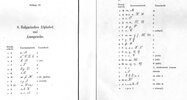H
Hoeksel
Guest
I have a set of 2 rare cases. They are 77x230 FK1896 cases reworked to be 75x200 cases for the FK16 nA. The "normal" one has number 6343a. Recently I found a case from 1924 that is reworked to adapt a different primer. A C/13 German primer is slightly smaller. An Italian Model 1935 primer seems to fit nicely but it does not look "OK". Does anybody know for which primer/country the rework was done? The stamp "R" is used by the French to indicate rework but I cant imagine the case being of French use.



